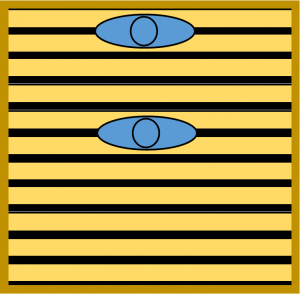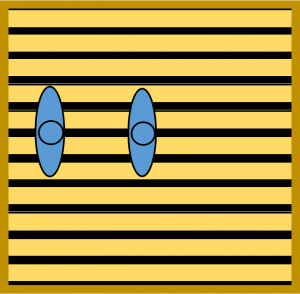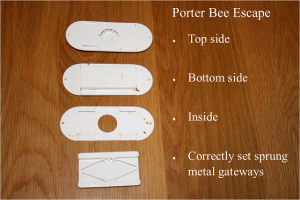If you’re looking at taking your honey off you’ll be looking at clearing the bees. If you’re in a hurry and you like a fight you can always shake them or brush them off the frames. Or if you are Gadget Man and don’t care about young bees being blown all over the landscape you can get yourself a bee blower. But if you favour something slower, more gentle and less brutal you’re looking at a clearer board.
All clearer boards employ some species of bee-valve. Generally speaking – the faster they clear bees – the faster the bees will find their way back up again.
Porter bee escapes make for a slower clearer board but when correctly set they will not allow the bees to get back up again. Unfortunately they often get a bad press but if they are set up carefully and a few precautions are taken to maximise success – they’re brilliant, clearing supers 95% of the time without a fight.
This is a Porter Bee Escape (Click photo for a close up):
By the way, when a Crown Board has Porter bee-escapes fitted it becomes a Clearer Board. When you take them out it’s a crown board again. So there’s another advantage: other clearer boards are just clearer boards – full stop.
How to Succeed
- The top of a Porter bee escape is the side with the round hole in it – this is the side that needs to be uppermost into your crown board;
- Make sure the top bars of the brood box (underneath) are clear of brace comb etc which may block the bee escape exits;
- Make sure the bottom bars of the super frames (above) are clear of trailing curtains/projections or knobs of comb etc which can block the bee escape entrances and make sure there is a beespace;
- Your crown board should have a bee space top and bottom otherwise the entrance or the exits can easily be blocked or narrowed;
- Make sure the holes in the crown board are not too tight – the escapes should fit snugly. If they are tight and pinched from the sides, the metal strips can close up and prevent passage of bees or the plastic housing can buckle allowing the bees to make their way back up;
- The top-plate slides off a Porter bee escape (see photo above) so you can set the springs inside or clean it. Set the metal springs so the space between them is about 3-4mm – use yer loaf here – it needs to be wide enough to allow a bee to push through but narrow enough prevent it from returning.
- Most crown boards are equipped with two openings for bee escapes/feeders – one in the centre and one offset. DO NOT place the board so one escape is over the centre frame and the other one is over an outer frame like this:

Because the smell of the brood nest will only be wafting strongly through one hole.
It works better if you place the board so the escapes are perpendicular to the brood frames and both are lined up over the centre frames – thus:

This way the bees will be drawn, like Bisto kids, through both escapes by the smell of the brood nest below;

- Be prepared to wait for at least 24 hours. Ideally, if you were to put them in before lunch they should be clear by the afternoon of the following day.
Reasons for Failure
- Drones in the supers. These fat boys will either get stuck in the escapes like Winnie-the-Pooh in the rabbit hole and bung up the works or will simply gang together and refuse to even try. Drones will bung up any and all alternative clearer boards I know of.

- Queen in the supers. If your queen is in the supers, bees will not clear. In fact the maddening scent of the queen and brood in the supers may cause desperate bees to force their way up from the brood box;
- If there is brood in the supers – even if the queen is in the brood box – the nurse bees will not desert the brood and the supers will not clear;
- If there is unripe honey in the supers, the honey processors will stay on at work and slow the clearing process. However, if you wait for 48 hours even these bees should have cleared. If you put clearer boards in in the morning, the honey brought in the previous day should have at least part-ripened overnight;
- If your supers or roof are not bee-proof, your supers will fill up with robbers as quickly as the resident bees clear;
- If you inadvertantly bought cheap crown boards, the flimsy plywood can bow so it touches or nearly touches the top bars of the frames below so the bee escapes won’t seat properly. If you deliberately bought cheap crown boards – this is one reason why that wasn’t a good idea. The other reason is that the same fault can also prevent bees accessing feeders.
Good luck!
Copyright © Beespoke.info, 2015. All Rights Reserved.

Good clear information. Thanks
Very interesting article as I’m just new to beekeeping this summer. I find my crown board with Porter escapes in it the bees still get into the roof and are trapped open or closed I’ve no idea what I’m doing wrong there is a gap around both ends of the Porter but is it meant to have those
As a beginner beekeeper I found this article very useful -thanks!
Great – that makes it all worth while!
Thankyou this is so helpful. I’ve been trying with limited success to move all my bees from an over wintered super moved to above the brood box to over it. There’s still lots of stores in the brood box and the colony is doing well so I wanted to remove the super which has a mixture of winter stores / inverted syrup so I am prepared for the spring honey flow. The porter bee escapes haven’t worked well. I can now see it might be down the brace comb under the super as I checked the springs. I’ve tried putting a rhombus escape on one of the holes in the crown board and this hasn’t worked either. Around 70% bees have cleared but I can now see that bees will be finding their way back up through the rhombus as it’s been on 36 hours. As the weather has turned and these bees may be stuck I think it’s best to quickly remove it replace the queen excluder and have another go when the weather is better. Do you agree? Thanks for your v helpful article
If it was me I’d be tempted to shake the rest out but if it’s too cold, it’s too cold and it’d do no harm to put in the queen excluder and try again later.
However, make sure your queen hasn’t got into the super!
Or been and laid in the super!